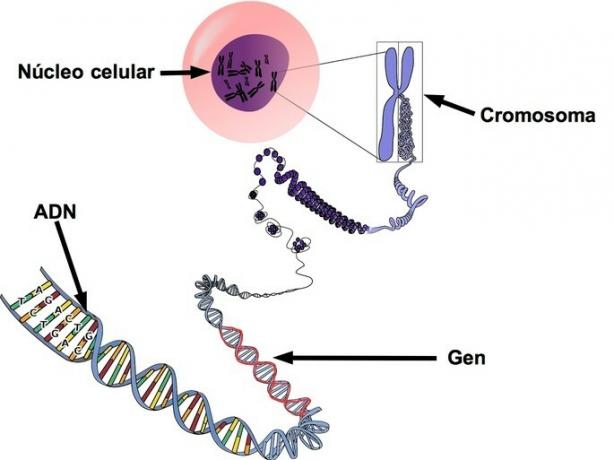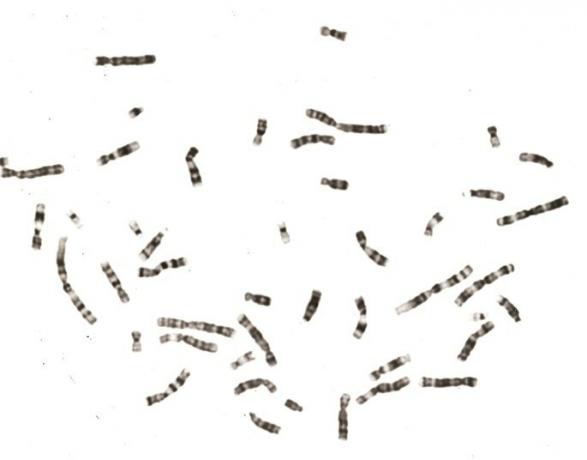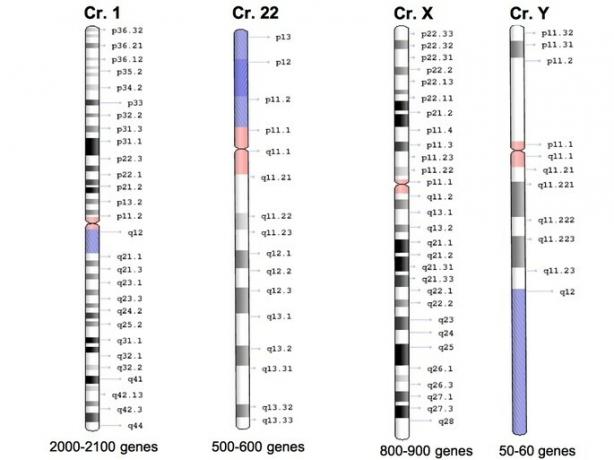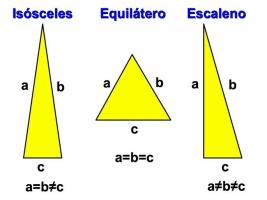Difference between genes and chromosomes
A gene It is a portion of deoxyribonucleic acid (DNA) that codes for a protein or RNA. A chromosome It is a nuclear structure that corresponds to the packaging of DNA where a number of genes are found. In other words, the chromosome is a large portion of DNA, the molecule in charge of the genetic information of living beings, which is expressed through genes.
| Gen | Chromosome | |
|---|---|---|
| Definition | Functional unit of inheritance | Linear DNA packaging structure |
| Location | On the chromosomes | In the cell nucleus |
| Composition | DNA | Chromatin: DNA and proteins |
| Types |
Structural genes Regulatory genes Specialized genes Constitutive genes Pseudogenes |
According to function in the cell:
According to the location of the centromere:
|
| Examples |
ACTB gene: actin gene. BRCA1 gene: tumor suppressor gene. INS gene: insulin gene. |
Homo sapiens: 46 chromosomes Mus musculus: 40 chromosomes Gorilla gorilla: 48 chromosomes |
What are genes?

Genes are the functional units of heredity. A gene is defined as a DNA sequence segment corresponding to a protein, a set of protein variants, or structural RNA molecules that do not produce proteins.
The Human Genome Project determined that the human being has 20,000-25,000 genes in his genome in the 3 billion base pairs of DNA. The fruit fly Drosophila melanogaster has approximately 14 thousand genes in 137 million base pairs and the plant Arabidopsis thaliana owns approx. 26 thousand genes in 142 million base pairs of DNA.
Genes in eukaryotic cells present:
- Promoter region: DNA sequence that precedes the sequence that codes for a protein. It is the region that controls the transcription of the gene.
- Coding region: DNA sequence transcribed into mRNA to later be translated into an amino acid sequence.
- Exons: DNA sequences that occur in the definitive messenger RNA.
- Introns: intermediate sequences that are eliminated in the messenger RNA.
Gene types
Genes can be of the following types:
- Structural genes: as the ACTB gene that encodes the actin protein, important in the cytoskeleton of the cell.
- Regulatory genes: they code for proteins that regulate the transcription of other genes.
- Specialized genes: genes that are only expressed in certain cells; for example the globin gene in red blood cell precursors.
- Maintenance genesor constitutive (of English housekeeping genes): they are genes whose transcription is constant in the cell and which fulfill the basic functions of the same.
- Pseudogenes: they are non-functional genes, the result of the accumulation of mutations.
Genes function
Genes are the elements that contain the information that determines the characteristics of the species. They also control the development and functions of cells. For example, the BRCA1 gene on human chromosome 17 encodes a protein that maintains genome stability and acts as a tumor suppressor.
What are chromosomes

Chromosomes are threadlike structures found inside the nucleus, made up of DNA and proteins. The eukaryotic cells of each species of a living being possess a characteristic fixed and constant number of chromosomes. For example, him Homo sapiens it has 23 pairs of chromosomes or 46 chromosomes.
Chromosomes are visible under a microscope when cells begin to divide. In a given species, chromosomes can be identified by their number, size, centromere position, and banding pattern. The karyotype it is the number and appearance of human chromosomes.
In organisms where sexual reproduction exists, sex cells or gametes have only one set of the chromosomes of the species, that is, they are haploid. For example, in humans, eggs have 23 chromosomes and sperm also have 23 chromosomes.
The number of chromosomes is not related to the complexity of the organism, for example, in somatic cells of humans there are 46 chromosomes, in mice 42, in bovines 60.
Chromosome structure
Each chromosome has:
- a narrowing called centromere;
- final extremes known as telomeres;
- two arms, one small or arm p (by the French petit) and a long one or arm that.
Chromosome types

In living beings where two sexes differ, chromosomes are classified into:
- Somatic chromosomes: are those identical chromosomes between the individuals of a species, regardless of their sex. In humans there are 22 pairs of somatic chromosomes also called homologous chromosomes.
- Sex chromosomes: they are a pair of chromosomes that determine the sex of the individual. In humans, a pair of X chromosomes (XX) determines that the individual is female, while an X chromosome and a Y chromosome (XY) determine that the individual is male.
Additionally, chromosomes can be classified according to the position of the centromere in:
- metacentric chromosomes: the centromere is in the middle of the chromosome;
- submetacentric chromosomes: the centromere is located at one end;
- acrocentric chromosomes: the centromere is very close to the extreme end, which produces a very small p-arm;
- telocentric chromosomes: the centromere is exactly at the extreme.
Chromosome function
The main function of chromosomes is the DNA packaging within the nucleus. Human DNA comprises more than 3 billion base pairs, which if it could be extended would be 2 meters long, but the nucleus is barely 0.000006 meters long!
Chromosomal abnormalities
Chromosomal disorders where there is a change in the number of chromosomes of the species is known as aneuploidy, among which we have:
- Trisomy: given by the presence of an extra chromosome in the cell. For example, Down syndrome or trisomy 21 is characterized by having three copies of chromosome 21, instead of the two normal copies.
- Monosomy: given by the absence of a chromosome in the cell. For example, Turner syndrome, where there are only 45 chromosomes with a single X chromosome.
You may also be interested in seeing:
- Differences between DNA and RNA.
- Gene and allele
- Genotype and phenotype

Doctor in Biochemistry from the Venezuelan Institute of Scientific Research (IVIC), with a degree in Bioanalysis from the Central University of Venezuela.



